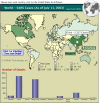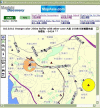Descriptive review of geographic mapping of severe acute respiratory syndrome (SARS) on the Internet
- PMID: 14748926
- PMCID: PMC343293
- DOI: 10.1186/1476-072X-3-2
Descriptive review of geographic mapping of severe acute respiratory syndrome (SARS) on the Internet
Abstract
From geographic mapping at different scales to location-based alerting services, geoinformatics plays an important role in the study and control of global outbreaks like severe acute respiratory syndrome (SARS). This paper reviews several geographic mapping efforts of SARS on the Internet that employ a variety of techniques like choropleth rendering, graduated circles, graduated pie charts, buffering, overlay analysis and animation. The aim of these mapping services is to educate the public (especially travellers to potentially at-risk areas) and assist public health authorities in analysing the spatial and temporal trends and patterns of SARS and in assessing/revising current control measures.
Figures







References
-
- World Health Organisation – Communicable Disease Surveillance & Response (CSR) Severe Acute Respiratory Syndrome (SARS) http://www.who.int/csr/sars/en/
-
- Zambon M. Severe acute respiratory syndrome revisited. Br Med J. 2003;326:831–2. doi: 10.1136/bmj.326.7394.831. http://bmj.com/cgi/content/full/326/7394/831 - DOI - PMC - PubMed
-
- Chan-Yeung M, Yu WC. Outbreak of severe acute respiratory syndrome in Hong Kong Special Administrative Region: case report. Br Med J. 2003;326:850–2. doi: 10.1136/bmj.326.7394.850. http://bmj.com/cgi/content/full/326/7394/850 - DOI - PMC - PubMed
-
- Spurgeon D. Canada reports more than 300 suspected cases of SARS. Br Med J. 2003;326:897. doi: 10.1136/bmj.326.7395.897/a. http://bmj.com/cgi/content/full/326/7395/897/a - DOI - PMC - PubMed
-
- Ksiazek TG, Erdman D, Goldsmith CS, Zaki SR, Peret T, Emery S, Tong S, Urbani C, Comer JA, Lim W, Rollin PE, Dowell SF, Ling AE, Humphrey CD, Shieh WJ, Guarner J, Paddock CD, Rota P, Fields B, DeRisi J, Yang JY, Cox N, Hughes JM, LeDuc JW, Bellini WJ, Anderson LJ. A Novel Coronavirus Associated with Severe Acute Respiratory Syndrome. N Engl J Med. 2003;348:1953–1966. doi: 10.1056/NEJMoa030781. http://content.nejm.org/cgi/pmidlookup?view=reprint&pmid=12690092 - DOI - PubMed
LinkOut - more resources
Full Text Sources
Miscellaneous

